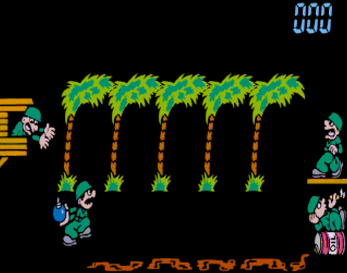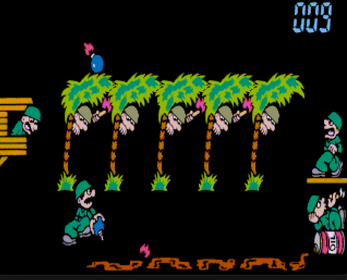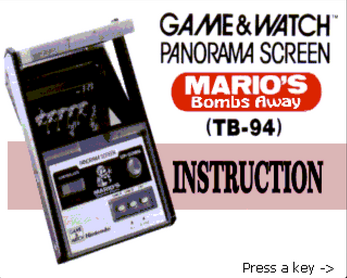Mario's Bombs Away for ZX Next
A downloadable game
Hola amigo!
(English belows)
Aquí me tienes otra vez para presentarte mi última recreación de una Game and Watch para Sinclair ZX Next.
Motivación:
Este juego surge de la curiosidad por usar la Layer2 de 320x256 en el ZX Spectrum Next combinada con la petición de Javi Ortiz de hacer un juego de su infancia.
Se convierte en la séptima recreación de Game and Watch que hago para ordenadores Sinclair (5 para Spectrum y 2 para Spectrum Next)
El desarrollo me ha llevado unos 3 meses de tiempo dedicando un par de horas a la semana.
El Juego:
Mario's Bombs Away es un videojuego de acción desarrollado por Nintendo Research & Development 1 y publicado por Nintendo de Game & Watch lanzado como parte de la serie Panorama Screen el 10 de noviembre de 1983.
El juego involucra a Mario, un soldado en este juego, en una misión para recibir una bomba de su compañero en el lado izquierdo de la pantalla y llevarla a su tropa en el otro lado . Los soldados enemigos esperan en los árboles en su camino, por lo que debe mantener su bomba alejada de sus antorchas. Uno de sus camaradas es el Heavy Smoker, que es un holgazán que descuidadamente arroja cigarros encendidos a un chorro de aceite derramado, por lo que Mario también debe evitar que la bomba se encienda en el suelo. Mario gana un punto cada vez que avanza un paso hacia la derecha mientras lleva una bomba. Cuando llega al otro lado, debe pasar con cuidado la bomba a su amigo, quien la arroja a uno de los cinco árboles, dándole cinco puntos a Mario. Después de arrojar cinco bombas a los árboles, explotan sobre el enemigo y recompensan a Mario con 10 puntos. A medida que pasa el tiempo, las antorchas y el fuego en el suelo se mueven más rápido. Si la bomba de Mario se enciende, se retirará a su puesto de avanzada, donde la bomba detonará en su cara y explotará su puesto de avanzada, lo que le permitirá fallar. Si Mario alcanza los 300 puntos sin fallar, los puntos valdrán el doble hasta que falle. Si tiene algún error en dicho puntaje, cada error se borrará en su lugar. El juego termina cuando fallas tres veces.
Datos técnicos:
- El juego se construyó desde cero usando ZX Basic con la librería Nextbuild y compilado con Boriel compiler. Usa rutinas asm para pintar los sprites en pantalla. (No son sprites Next sino BMP convertidos a un formato propietario para permitir pintar sprites de más de 16x16 sin linkar)
- Usa la layer2 de 320x256 colores combinada con la ULA para poner algunos textos en pantalla.
- Los sprites son realmente bmp con formato RRRGGGBB convertidos a un formato binario para poder ser pintados en pantalla con asm. Sólo el archivo de sprites ocupa 67KBytes que se cargan en bancos altos de memoria Next.
- Se obtuvo la pantalla completa del juego original, se convirtió a 320x256, se aplanaron los colores y se fue recortando sprite a sprite.
- La música son archivos pt3 que se interpretan por interrupciones.
- Los efectos de sonidos son wav sampleados y convertidos a formato AYFXEdit (afb).
- Las teclas son redefinibles y es compatible de origen con Kempston Joystick.
Agradecimientos:
- A Javi Ortiz por tu enorme labor de difusión de la escena Spectrum que permite mantener viva la máquina de nuestra infancia.
- A José Boriel: Hay un antes y un después en el desarrollo Spectrum/Next gracias a tu maravilloso compilador.
- A Duefectu: por tu libro de desarrollo para ZX Basic Boriel.
- A David Shapier por tu librería NextBuild (para mi imprescindible si quieres programar para Next)
- A Tomaz Krajel por su “Assembly Developer Guide” para Next. Clave para trabajar con la layer2 de 320x256 y todos los NextReg del Next.
- Y a los desinteresados testers David Programa y PacoVespa por sus sugerencias y testeo.
Que lo disfrutes!!!
---------------------------------------------------------------------------------
Hi mate!
Here I am again to present you my last recreation of a Game and Watch for Sinclair ZX Next.
Motivation:
This game comes from the curiosity to use the 320x256 Layer2 on the ZX Spectrum Next combined with Javi Ortiz's request to make a game from his childhood.
It becomes the seventh Game and Watch recreation I make for Sinclair computers (5 for Spectrum and 2 for Spectrum Next).
The development has taken me about 3 months of time dedicating a couple of hours a week.
The Game:
Mario's Bombs Away is an action video game developed by Nintendo Research & Development 1 and published by Nintendo from Game & Watch released as part of the Panorama Screen series on November 10, 1983.
The game involves Mario, a soldier in this game, on a mission to receive a bomb from his partner on the left side of the screen and carry it to his troop on the other side. Enemy soldiers wait in the trees in his path, so he must keep his bomb away from their torches. One of his comrades is the Heavy Smoker, who is a slacker who carelessly throws lit cigarettes into a stream of spilled oil, so Mario must also keep the bomb from igniting on the ground. Mario earns a point each time he advances one step to the right while carrying a bomb. When he reaches the other side, he must carefully pass the bomb to his friend, who throws it into one of the five trees, giving Mario five points. After throwing five bombs into the trees, they explode on the enemy and reward Mario with 10 points. As time passes, the torches and fire on the ground move faster. If Mario's bomb ignites, he will retreat to his outpost, where the bomb will detonate in his face and blow up his outpost, allowing him to miss. If Mario reaches 300 points without failing, the points will be worth double until he fails. If you have any errors in that score, each error will be erased instead. The game ends when you fail three times.
Technical data:
- The game was built from scratch using ZX Basic with the Nextbuild library and compiled with Boriel compiler. It uses asm routines to paint the sprites on screen (they are not Next sprites but BMP sprites converted to a proprietary format to allow painting sprites bigger than 16x16 without linking).
- Use the 320x256 color layer2 combined with the ULA to put some text on screen.
- The sprites are actually bmp with RRRGGGBB format converted to a binary format to be able to be painted on screen with asm. The sprite file alone occupies 67KBytes which are loaded in high banks of Next memory.
- The full screen of the original game was obtained, converted to 320x256, colors were flattened and sprite by sprite was trimmed.
- The music is pt3 files that are played by interruptions.
- The sound effects are wav sampled and converted to AYFXEdit (afb) format.
- The keys are redefineable and it is Kempston Joystick compatible.
Acknowledgements:
- To Javi Ortiz for your enormous work of diffusion of the Spectrum scene that allows to keep alive the machine of our childhood.
- To José Boriel: There is a before and after in Spectrum/Next development thanks to your wonderful compiler.
- To Duefectu: for your ZX Basic Boriel development book.
- To David Shapier: for your NextBuild library (for me essential if you want to program for Next).
- To Tomaz Krajel for his "Assembly Developer Guide" for Next. Key to work with the 320x256 layer2 and all the NextRegs in Next.
- And to the disinterested testers David Programa and PacoVespa for their suggestions and testing.
Enjoy it!!!
Download
Click download now to get access to the following files:
Development log
- Release Wed 21:30 CET!!!Jul 09, 2024
- New release Soon!!!Jul 07, 2024



Comments
Log in with itch.io to leave a comment.
Nos tienes mal acostumbrados amigo Sergio!!!! Otro clasicazo, otro juegazo, otro desarrollo donde le pones todo tu empeño y cariño. Se nota que lo haces con total amor para el sistema (tanto el original como, en este caso Spectrum (ZX y Next). La parte mala es que....YA ESTAMOS DESEANDO VER EL SIGUIENTE!!!! Felicidades!!!
Un juego muy entretenido, una obra de arte con sabor a principios de los años 80. Un abrazo.
Gracias Raúl!!!